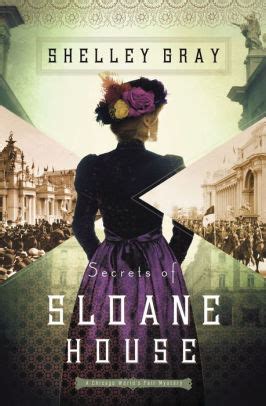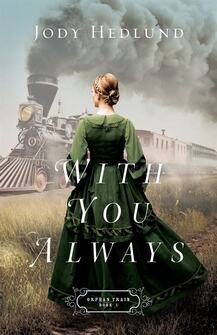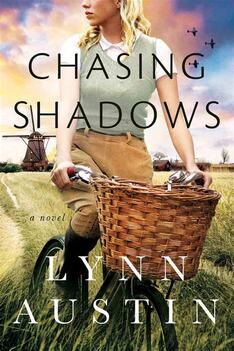|
Summary
Against the backdrop of the 1893 World’s Fair, a new kind of crime comes to Gilded Age Chicago . . . and a lonely young woman is always at risk. Back on the farm in Wisconsin, Rosalind’s plan had seemed logical: Move to Chicago. Get hired on at Sloane House, one of the most gilded mansions of Chicago. Discover what transpired while her sister worked as a maid there―and follow the clues to why she disappeared. Now, as a live-in housemaid to the Sloanes, Rosalind realizes her plan had been woefully simple-minded. She was ignorant of the hard, hidden life of a servant in a big, prominent house; of the divide between the Sloane family and the people who served them; and most of all, she had never imagined so many people could live in such proximity and keep such dark secrets. Yet, while Sloane House is daunting, the streets of Chicago are downright dangerous. But when Rosalind accepts the friendship of Reid Armstrong, the handsome young heir to a Chicago silver fortune, she becomes an accidental rival to Veronica Sloane. As Rosalind continues to disguise her kinship to the missing maid―and struggles to appease her jealous mistress―she probes the dark secrets of Sloane House and comes ever closer to uncovering her sister’s mysterious fate. A fate that everyone in the house seems to know . . . but which no one dares to name. Positives The Victorian vibes of the novel were great. And there were so many red herrings in the mystery. It kept me guessing every direction I turned. I was annoyed with the characters I was supposed to be annoyed with—and others that I knew I should be annoyed with turned out to have interesting facets. When all was said and done, I truly did not expect the culprit. The resolution of the story also actually showed the culprit’s family dealing with the fallout—a rarity. Negatives However, some scenes got repetitive really fast. (I see this happen in my own writing a lot.) Scene: Rosalind talks to a member of the staff who warns her not to look for her sister. Next scene: Rosalind talks to somebody new who warns her not to look for her sister. Next scene: Rosalind talks to somebody different who warns her not to look for her sister. While the culprit did surprised me, the answer to Miranda’s disappearance did not. Nothing much stood out about Rosalind. She could have been any other female character in any other book. The whole story revolved around her finding herself and ultimately realizing that she was a stronger, braver person than before. Except she really wasn’t—she just had Reid there to save the day for her. Also, her pouring her whole life story—including her secret identity and her sister’s disappearance—to a guy whom she’s never met before? A little sketchy. The wealthy man's son always taking advantage of maids trope also didn't catch my attention. This seems to be a very tired-out trope in historical romances. The book had some really random info-dumps in really weird places. While they didn’t ruin the book for me, they could have been solved with some thought and editing. For instance, one chapter ended and the next began with, “Reid’s brother died when he was young.” While this was important to know, we got some random pages that didn’t really fit in the narrative—nothing had triggered Reid thinking of this. Then we jerked back to Reid in the ballroom somewhere. Add on to this one lonely scene from a side character's point of view which seemed put there only to set her up for the second book. Conclusion Secrets of Sloane House is a fantastic mystery, but slowed down just a bit by lack of character depth and a few scenes of clunky writing. Still, it was the perfect low-key read for a fall evening.
0 Comments
Summary
Could Following the Opportunity of a Lifetime Cost Them the Love of Their Lives? One of the many immigrants struggling to survive in 1850s New York, Elise Neumann knows she must take action to care for her younger sisters. She finds a glimmer of hope when the New York Children's Aid Society starts sending skilled workers to burgeoning towns out west. But the promise of the society's orphan trains is not all that it seems. Born into elite New York society, Thornton Quincy possesses everything except the ability to step out from his brother's shadow. When their ailing father puts forth a unique challenge to determine who will inherit his railroad-building empire, Thornton finally sees his chance. The conditions to win? Be the first to build a sustainable community along the Illinois Central Railroad and find a suitable wife. Thrown together against all odds, Elise and Thornton couldn't be from more different worlds. The spark that ignites between them is undeniable, but how can they let it grow when that means forfeiting everything they've been working toward? Positives I loved Thornton right away. His first chapters nailed it. I related so much to him wanting approval like his brother receives. While I didn’t like Elise as much, I did relate to her trying to protect and take care of her siblings. While both he and Elise developed negative traits that made them unlikeable at times (see below), maybe that was the whole point. None of those negative traits stuck around until the end. They overcame them in the course of the story. They became better people. And isn’t that what life is? The tension was brilliant. By instituting the bet between Thornton and this brother, it kept me turning pages even through slower sections. The concept felt fresh and unique. Reinhold was fantastic as the other corner of the love triangle. He was supportive even when Elise didn’t reciprocate his feelings. We need more characters like that. While Thornton had me rooting for him, I have to admit, there were a couple times when Thornton was being obsessed and creepy that I wondered if Reinhold was a better option. I'm hoping Reinhold appears in the next book in the series. Negatives At time, both main characters were extremely unlikeable. Elise was very wishy-washy and a bit on the weepy side. Characters repeatedly called her strong and independent, but she didn’t really think or act that way (especially not in the beginning). Thornton was obsessed and selfish. And the way he kept sneaking up to Elise and touching her? I think it was supposed to be romantic, but it was really just super creepy, especially since Elise was not consenting to this action. None of these traits were set up in the first act and just blasted onto the page somewhere in the second act (unless I missed the set up). It was a bit of a jolt. I really, really disliked Marianne. She drove me insane. She was constantly weeping and whining and throwing herself at this guy. And then lied to him and about him. And then when she got in trouble for it, had the nerve to weep and whine some more about her misfortune. Maybe this will be developed more in the second book and she will be made more likeable, but she really didn’t add a whole lot to the current plot, especially since most of her story was summed up in Reinhold telling Elise about her letters. While I want Reinhold to appear in the next one, I really hope for his sake and mine that he doesn't get paired up with Marianne. Conclusion With You Always isn’t a perfect book. Neither are its characters. But that’s part of the intrigue and beauty of this book. Summary For fans of bestselling WWII fiction comes a powerful novel from Lynn Austin about three women whose lives are instantly changed when the Nazis invade the neutral Netherlands, forcing each into a complicated dance of choice and consequence. Lena is a wife and mother who farms alongside her husband in the tranquil countryside. Her faith has always been her compass, but can she remain steadfast when the questions grow increasingly complex and the answers could mean the difference between life and death? Lena’s daughter Ans has recently moved to the bustling city of Leiden, filled with romantic notions of a new job and a young Dutch police officer. But when she is drawn into Resistance work, her idealism collides with the dangerous reality that comes with fighting the enemy. Miriam is a young Jewish violinist who immigrated for the safety she thought Holland would offer. She finds love in her new country, but as her family settles in Leiden, the events that follow will test them in ways she could never have imagined. The Nazi invasion propels these women onto paths that cross in unexpected, sometimes-heartbreaking ways. Yet the story that unfolds illuminates the surprising endurance of the human spirit and the power of faith and love to carry us through. Positives Ans was my favorite character and plotline in this book. At first, I didn’t think I would like her—the “rebellious” teenager who wants to see more of the world has been so overdone and isn’t that true to life, I’m finding. But as the book went on, she developed into a sympathetic character. I loved that her plotline didn’t end with pat answers, that it changed it up a little bit. She struggled with real questions in very real ways and found real answers. Lena was my second favorite. Because who can’t relate to wanting control when everything is nose-diving? Miriam was my least favorite. Her story was just something that happens in so many novels. Girl meets guy, they fall in love, get married, have a baby, are separated for some reason, and spend the rest of the book crying and searching for each other. That being said, I loved the connection of her violin. And the emotion she worked through while giving her child up was very real and raw, giving a good glimpse into what mothers of the time actually would have been feeling. The prologue did exactly its job! It makes you want to figure out how the characters got there, but doesn’t give away how it ends. I also loved the inclusion of Ans’ friend who is fighting depression. It is a topic that needs addressed more in fiction and often gets glossed over or sensationalized in historical fiction. Negatives The book felt a little detached from the characters sometimes. This may have been just part of the writing voice of this one, but I would have liked to get inside the heads of the characters some more. There were also some of the spies that worked with Lena that I would have loved to know more about. In fact, the ending seemed a tad bit on the rushed side. But there were also three plotlines to be closed up and only a few pages to do it in. Honestly, the author did fantastic juggling those three plotlines. Summary Chasing Shadows is definitely worth a read. While it doesn’t dive into the characters’ heads too much, it does provide a realistic glimpse into what life in the time was like. Summary A story of second chances and secrets, this mysterious Regency romance will transport you to 19th-century England as one young lady reunites with her childhood love to find his missing sister. Her friend is missing. After five years abroad, Charity Halliwell finally returns to Loxby Manor, the home of dear friends—and her lost love. No longer a young girl, she is now haunted by a painful secret and the demise of her dreams. Instead of the healing and happiness she hopes to find, she encounters a darkness lurking in the shadows of the once-familiar house. When her friend, Seline, disappears the very night of her arrival, Charity is determined to uncover the truth. Her only hope is the man who broke her heart. Branded a coward, Piers Cavanaugh has lived the last five years as an outcast far from his family home. When his sister presumably elopes with a stable hand, Piers joins forces with an unlikely partner—the one woman he thought he’d never see again. Together they launch an investigation that leads to strange nightly meetings in the ruins of an old abbey and disturbing whispers of a secret organization. The more they learn, the more desperate the situation becomes. The house seems determined to keep its secrets. As they struggle to piece together the clues, Charity and Piers also endeavor to rebuild their friendship. One cryptic letter changed everything between them. To find happiness they will have to overcome the grief and shame keeping them apart. But first they must discover why Seline vanished and confront the growing fear that she may never return. Settle in, because once you start The Vanishing at Loxby Manor, you won’t be able to put it down. Positives I rolled my eyes a bit when I first met Charity. Here we go. Another “traumatized” female character who jumps at every shadow and bursts into tears. But Charity wasn’t like that. Yes, she was slow to trust, and could get spooked easily. But it was realistic—it actually took into consideration what actual people who have been through her kind of trauma are like, and recognized that there are as many reactions to trauma as there are personalities and people. While the author acknowledged the struggle this brought Charity, she also gave Charity her strengths, too. This mystery was so well done. I had no idea who had done it. Everyone could have been suspects. (And they were until proven otherwise.) Good characters had dark sides. Bad characters had good sides. It also had a very interesting premise—the idea of the secret societies that did, in fact, exist in that time period is rarely, if ever, explored in historical fiction. Selina’s mother was an especially intriguing character to me. One moment, she ruthlessly defended her family’s “honor” with no thought to her children. The next, she was coming to confide in Charity. And the next she was almost motherly. Very much a three-dimensional character and an interesting addition to the story. Negatives The back cover is a bit misleading when it says Piers broke her heart. He really didn't--the trauma Charity faced separated the two of them. Conclusion All in all, a clever Regency mystery that takes a very specific form of trauma and handles it sympathetically. |
Rachel's Reads
Hi there! Rachel again. Check out this section for book reviews and cover reveals of some of my favorites! Archives
June 2023
Categories
All
|




